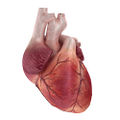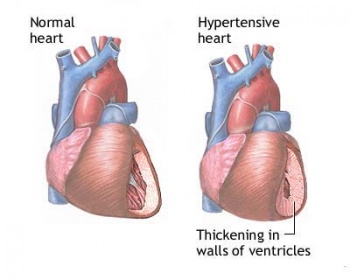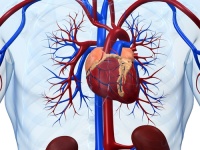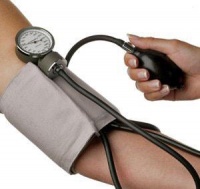Hypertension (High Blood Pressure)
|
Hypertension | |
| Causes | Dietary Factors, Smoking, Stress |
|---|---|
| See Also | Cardiovascular Conditions, Hypotension |
| Books | Books on Cardiovascular Conditions such as Naturopathic Treatment of Blood Pressure and others. |
| Articles | Articles on Cardiovascular Conditions |
Blood pressure is a measure of the force of blood against the walls of arteries, veins, and the chambers of the heart as it is pumped through the body.[1] High blood pressure refers to the elevation of systolic and/or diastolic blood pressure. It is the most common of all cardiovascular diseases in industrialized nations and it is a major cause of heart attacks, stroke, and congestive heart failure. Hypertension affects about a third of all North Americans over the age of 20, with increased incidence in black populations. Hypertension is relatively uncommon in cultures untouched by a western lifestyle. [2] Fluctuations in blood pressure are normal. Blood pressure, in a healthy state, will fluctuate throughout the day, by season, based on activity level, and in response to different stressors. When high blood pressure is consistently present it begins to weaken blood vessel walls and makes it easier for harmful substances, such as toxins and cholesterol plaques to deposit and further decrease the diameter of blood vessels.[1] High blood pressure readings are a concern when they remain elevated for an extended period of time. Hypertension can be a serious condition as it can damage the arteries and the heart and can ultimately lead serious complications and death if left untreated.[3]
Naturopathic Assessment
| Article | Cortisol Reactivity; A Novel Risk Factor for Hypertension , IHP ; April/May 2013 |
|---|
The assessment of hypertension is commonly based on a person's health history and on a physical exam. There are many causes of high blood pressure that need to be addressed in a thorough assessment, and possible underlying life threatening conditions need to be ruled out by a qualified health care professional.[4]
Causal Factors
The factors that contribute to hypertension are complex and varied. Major modifiable causal factors include lifestyle, stress, and diet.
Lifestyle
| Read this article | The Role of the ‘Eubiotic’ Diet in Intestinal Dysbiosis and Hypertension, IJNM; 2009 July;Vol4(1) |
|---|
| Check out this book | The Anti-Inflammation Diet and Recipe Book: Protect Yourself and Your Family From Heart Disease, Arthritis, Diabetes, Allergies - and More |
|---|
| Check out this book | Blood Pressure: A Naturopathic Approach |
|---|
| Check out this book | Integrative Medicine and Functional Medicine for Chronic Hypertension |
|---|
| Check out this book | Naturopathic Treatment of Blood Pressure |
|---|
- Dietary factors include:
- A diet high in fat, refined salt, excess meat protein, simple carbohydrates, high saturated fats or low in essential fatty acids, potassium or low in calcium, magnesium and Vitamin C.[5]
- Excess calories, caffeine and alcohol intake are also factors.[6]
- Low potassium leads to depletion of magnesium at a tissue level which can contribute to hypertension.[7]
Social
- Stressfull situations can cause a temporary increase in blood pressure. Ongoing, unrelenting stress can also contribute to chronic hypertension.[9]
- Recurring blood pressure elevation caused by emotional distress eventually leads to structural vascular changes and sustained hypertension.[10][11]
- Emotional distress transiently raises blood pressure in real life.[10][12]
- Studies indicate that hypertensive individuals report less emotional distress and are more defensive, than normotensive individuals.
- Hypertension may first appear years or decades after stressful events, which makes the temporal relationship sometimes difficult to ascertain.[10]
Environmental
- Studies have shown that adequate time outside can reduce the risk of cancer, diabetes, osteoporosis and high blood pressure.[13]
External
- Trauma
Medical Interventions
- Prescription Medications
- Pharmaceutical drugs and some over-the-counter medications are known to cause or aggravate high blood pressure including non-steroidal anti-inflammatories. [19]
- Oral contraceptives have been shown to moderately increase the risk of hypertension.[20]
- The administration of diuretics may actually increase the risk of sudden cardiac death due to the depletion of potassium and magnesium.[8]
- Calcium channel blocking drugs may increase the risk of heart attack, cancer, and have been shown in some populations to increase risk of gastrointestinal hemorrhage.[21][22][23]
- The use of beta blockers has been shown to cause deficiency in Coenzyme Q10.[24]
Diagnostic Testing
| Article | Hypertensive Retinopathy, NDNR, 2011 October |
|---|
Hypertension is often initially diagnosed during routine physical exam. In oder to confirm a diagnosis of hypertension, three separate readings are required. No other testing is needed to diagnose hypertension, however other tests may be ordered to rule out associated diseases or conditions.[4]
- Urine tests including Urinalysis
- Blood tests including creatinine, potassium, glucose, calcium and uric acid, cholesterol panel.
- Other diagnostic testing including an ECG or Stress test.
- Observable changes in retinal blood vessels are diagnostic indicators of the degree of damage caused to the body due to hypertension.[2]
- Vertex pattern baldness appears to be a marker for increased risk of CHD events, especially among men with hypertension or high cholesterol levels.[25]
Related Symptoms and Conditions
Conditions associated with hypertension include:[4]
- Atherosclerosis
- Obesity
- Type II Diabetes
- High Cholesterol
- Hypothyroidism
- Hyperparathyroidism
- Primary aldosteronism (8% of hypertension cases)
Characteristics
Hypertension is characterized by either a systolic blood pressure above 140 mm Hg or a diastolic blood pressure above 90 mm Hg. Systole occurs when the left ventricle of the heart is contracting to push blood throughout the body, and diastole occurs when the left ventricle is relaxed and the heart fills with more blood. The blood pressure numbers reflect the pressure in the arteries at these different times.
- The physiology of hypertension is complex, involving hormonal, vascular, inflammatory, and structural influences. Primary hypertension can be partially attributed to vascular remodeling which is a consequence of decreasing blood vessel diamater, deposition of cellular matrix, and decreased smooth muscle motility.[26]
- Hypertension is associated with chronic inflammation. Hypertensive individuals tend to have high circulating levels of TNF, IL-6 and other acute phase inflammatory proteins.[27] Rise in blood pressure causes inflammation of endothelium which in turn causes further rise in blood pressure - a vicious cycle. [26].
- Oxidative stress is a contributing factor.[28]
Classification of blood pressure for adults age 18 and older.[8]
| Category | Systolic (mmHg) | Diastolic (mmHg) |
| Optimal | <120 | <80 |
| Normal | <130 | <85 |
| High-normal (Borderline) | 130-139 | 85 to 89 |
| Hypertension | ||
| Stage 1 | 140-159 | 90 to 99 |
| Stage 2 | 160 to 179 | 100 to 109 |
| Stage 3 | >180 | >110 |
Common Symptoms
- For many people, hypertension does not produce any symptoms unless it is prolonged or severe. For others hypertensive incidents are associated with the following symptoms:[2]
- nausea
- vomiting
- headache
- trouble breathing
- nosebleed
- dizziness
- flushed face
- general malaise or tiredness.
Naturopathic Treatment
The goal of naturopathic treatment is to support and work in tandem with the healing power of the body and to address the causal factors of disease with individual treatment strategies. High blood pressure is typically considered a chronic disease and the therapeutic objectives involve addressing underlying and associated condtions, balancing fluids and electrolytes and relaxing cardiac and vascular muscle. Prevention of hypertension is much easier than cure.[29] It is always advisable to work with a naturopathic doctor before engaging in any treatment plan.
Home Care
Taking Blood Pressure
If high blood pressure is a concern or suspected, it is beneficial to monitor blood pressure on a daily or weekly basis. Blood pressure needs to be monitored by a naturopathic doctor or trained health professional whenever there are any changes to medication or treatment regimen.[5]
In order to ensure the most accurate blood pressure readings keep the following in mind:
- Ensure your feet are on the ground
- When taking your blood pressure your arm should be at the level of your heart and it needs to be relaxed
- Sit for at least 3 minutes before you take your blood pressure
- The second reading is generally the most accurate reading. Avoid taking multiple readings back-to-back
- Sit still and do not talk while your blood pressure is being taken
Monitoring Blood Pressure
The following are the guidelines when monitoring blood pressure:
- For general maintenance of blood pressure it is important to monitor your blood pressure on a weekly basis. Ideally at the same day, roughly same time of each day. The aim of taking blood pressure on a regular basis is to ensure that blood pressure is not creeping up.
- Whenever there are changes in how blood pressure is being treated; whether that means increasing, decreasing or adding new prescription medications or naturopathic treatments, it is recommended that blood pressure be taken randomly three times a day for a minimum of ten (10) days to ensure that blood pressure changes are in line with the new treatment plan.
- If there are any concerning symptoms that you believe are contributing to blood pressure changes it is recommended to take your blood pressure and to see how your blood pressure is responding. For example, if you feel that dizziness is due to hypotension of low blood pressure, or the increased swelling of your ankles reflect an increasing in blood pressure,
- When introducing new foods or foods high in salt it is important to take your blood pressure to monitor the impact on blood pressure.
- Significantly stressful events can increase blood pressure. Taking your blood pressure during times of stress is an important way of preventing a heart attack or other cardiovascular event.
Lifestyle
Lifestyle factors include: Many of the lifestyle factors to prevent and treat hypertension are identical to strategies to prevent and treat Atherosclerosis[5]
- Dietary
- Increase daily fibre through vegetables, nuts and seeds, legumes and 100% whole grains at each meal and increase fresh raw fruit for snacks.[30][31][32]
- A mediterranean diet may be recommended.[33]
- Use olive oil and small amounts of butter while avoiding rancid oils, deep fried foods, margarines, shortening, and heating of polyunsaturated oils.[30]
- A low sodium and high potassium diet is often beneficial.[34]
- Limit saturated fat intake to less than 7% of total energy, trans fat to less than 1% of total energy and cholesterol to 300mg per day.[31]
- Avoid sugar in concentrated forms such as sucrose, glucose, fructose, white sugar, brown sugar, corn syrup, maple syrup, honey and molasses.[30][31]
- Eliminate caffeine in all forms such as coffee, tea, and colas.[30]
- Limit alcohol intake.[30], [31]
- Avoid processed meats as they contain preservatives such as nitrates and nitrites, additionally avoid all food additives and preservatives.[30]
- Eat fish twice per week.[30], [31]
- Ensure that you drink adequate water on a daily basis.
Naturopathic Therapies
The prescribing of naturopathic therapies requires the guidance of a naturopathic doctor as it depends on a number of factors including the causal factors, a person's age, prescription medications, other conditions and symptoms and overall health. It is always advisable to work with a naturopathic doctor prior to taking any natural therapies. Naturopathic Therapies for hypertension include:
- Nutritional Foods include:[36]
- Fruits such as banana, lotus plumule.
- Vegetables, Roots, Nuts & Gourds such as celery, corn silk, taro, tomato, water chestnut.
- Other foods such as honey
- Clinical Nutritional Supplementation includes:
- Vitamins such as Vitamin B1, Vitamin B12, Vitamin C, Vitamin D, Vitamin E.[3], Methyltetrahydrofolate
- Minerals such as Magnesium bisglycinate[5], Potassium, Calcium[5].
- Amino Acids such as L-Arginine[37] L-Taurine [33], Alpha Lipoic Acid
- Other supplements such as Flaxseed oil, Wheat Grass, Essential Fatty Acids, Coenzyme Q10,[3] antioxidants,[38] bioflavonoids, lecithin, dark chocolate with high flavanol content made by low-heat processing.[39], Cod Liver Oil, Omega-3 Fatty Acids, PQQ
| Article | Botanical Interventions for Hypertension and Hypercholesterolemia, NMJ, [1], 2012 March |
|---|
| Read this article | Aged Garlic Extract Lowers Blood Pressure [2] |
|---|
Astragalus ("Astragalus membranaceus"), Oat straw (Avena sativa), Dandelion ("Taraxacum offinale"), Garlic ("Allium sativum"), Hawthorn ("Crataegus oxyacantha"), Mistletoe ("Viscum album), Valerian ("Valeriana officinalis"), Yarrow ("Achillea millefolium"), Rauwolfia (Rauwolfia erpentina), Skullcap (Scutellaria laterfolia), Siberian ginseng (Eleuthrococcus senticosis), Small leafed lime (Tilia cordata), Periwinkle (Vinca major/minor), Evening Primrose (Oenothera biennis), Olive (Olea europaea), Grape Seed Extract.
- Homeopathic remedies such as:[42][43]
- Aurum, Belladonna, Crataegus, Lachesis, Strontium carb, Veratrum viride, Viscum album.
- Complex homeopathics are often used in the management and treatment of hypertension.
- From the four pattern perspective hypertension is typically identified as one of the following: Yin-deficient and Yang deficient, Yin-deficient with Yang-excess, Hot Liver, Yin deficiency of Liver and Kidney. The treatment approach is based on the specific pattern that has been assessed.
- Other differentials to consider for constitutional treatment include: phlegm heat, damp heat, wind phlegm, Qi and Blood stagnation, Liver Yang rising and Liver fire.[44].
| Article | Acupuncture for Essential Hypertension, NDNR, 2011 October |
|---|
- Acupuncture has been shown to successfully treat essential hypertension[45] and is used to significantly reduce diastolic hypertension.[46]
- Accupuncture points commonly used to treat hypertension are selected based on diagnosis and commonly include: GB20, GB34, GV20, LI4, LI11, SP6, ST36, LR2, Taiyang, TW17, Anmian, KD3, PC6, ST40, CV4,CV6, LR3, UB18, ST9, ST36, LI11.[44]
- Accupuncture points commonly used to treat hypertension are selected based on diagnosis and commonly include: KI6, HT7, LI4, KI1, GV20, GV26, ST45, HT9, PC6, PC9.
- Hydrotherapy strategies such as Neutral bath are often used to treat hypertension[47], Constitutional treatment[47],
References
Reviewed by Iva Lloyd, BScH, RPE, ND [3]
- ↑ 1.0 1.1 Leviton Richard High Blood Pressure, Lower It Naturally Alternative Medicine Digest;16:pp42-47.
- ↑ 2.0 2.1 2.2 Hoffmann David (1992) Therapeutic herbalism: A correspondence course in phytotherapy
- ↑ 3.0 3.1 3.2 Pizzorno Joseph, Murray Michael, Joiner-Bey Herb (2003) The Clinician's Handbook of Natural Medicine, Churchill Livingstone
- ↑ 4.0 4.1 4.2 El-Hashemy Shehab(2007)Naturopathic Standards of Primary Care. CCNM Press Inc.:pg78-86
- ↑ 5.0 5.1 5.2 5.3 5.4 5.5 5.6 5.7 Smith Fraser, Winterstein James (2008) An Introduction to Principles & Practices of Naturopathic Medicine CCNM Press Inc., Toronto:pg128-131
- ↑ Murray Michael, Pizzorno Joseph.(1998) Encyclopedia of Natural Medicine 2nd edition. Three Rivers Press, New York:pg524-535
- ↑ Duarte CG (1978) Magnesium metabolism in potassium-depleted rats Am J Physiol Renal Physiol;234:466-471.
- ↑ 8.0 8.1 8.2 8.3 Murray MT, Pizzorno JE (2006) Pizzorno Textbook of Natural Medicine 3rd ed Chap 176 Hypertension Elsevier.
- ↑ Mann Samuel (Mar 2000) The Mind/Body Link in Essential Hypertension: Time for a new paradigm Alternative Therapies;6(2):39-45.
- ↑ 10.0 10.1 10.2 10.3 Mann Samuel J (Mar 2000) The Mind/Body Link in Essential Hypertension: Time for a new paradigm Alternative Therapies;6(2):39-44.
- ↑ Weder AB, Julius S (1985) Behavior, blood pressure variability and hypertension. Psychosaom Med;47:406-414.
- ↑ James GD, Yee LS, Harshfield GA, Blank SC, Pickering TG (1986) The influence of happiness, anger and anxiety on the blood pressure of borderline hypertensives: a preliminary report. Psychosom Med;48:502-508.
- ↑ Holick M (2004) Vitamin D: importance in the prevention of cancers, type 1 diabetes, heart disease, and osteoporosis. American Society for Clinical Nutrition;362-371.
- ↑ Telisman S, Jurasovic J, Pizent A, Cvitkovic P (2001) Blood pressure in relation to biomarkers of lead, cadmium, copper, zinc, and selenium in men without occupational exposure to metals Environ Res: 87:57-68
- ↑ Heitzer Thomas, Ylä-Herttuala Seppo, Luoma Jukka, Kurz Sabine, Münzel Thomas, Just Hanjörg, Olschewski Manfred, Drexler Helmut (1996) Cigarette Smoking Potentiates Endothelial Dysfunction of Forearm Resistance Vessels in Patients With Hypercholesterolemia. Role of Oxidized LDL Circulation;93:1346-1353.
- ↑ Simonetti Giacomo, Schwertz Rainer, Klett Martin, Hoffmann Georg, Shaefer Franz, Wühl Elke (2011) Determinants of Blood Pressure in Preschool Children, The Role of Parental Smoking Circulation;123:292-298.
- ↑ Pietrzak RH, et al (2012) Physical health conditions associatied with posttraumatic stress disorder in US older adults: results from wave 2 of the National Epidemiologic Survery on Alcohol and Related Conditions J Am Geriatr Soc 60(2)296-303
- ↑ De Gaudio AR, et al (2009) Acute Severe Arterial Hypertension: Therapeutic Options Curr Drug Targets 10(8):788-98
- ↑ Cooney D, Pascuzzi K (2009) Polypharmacy in the Elderly: Focus on Drug Interactions and Adherence in Hypertension Clin Geriatr Med; 25(2)221-33
- ↑ Chasan-Taber Lisa, Willett Walter, Manson JoAnn, Spiegelman Donna, Hunter David, Curhan Gary, Colditz Graham, Stampfer Meir (1996) Prospective Study of Oral Contraceptives and Hypertension Among Women in the United States Circulation;94:483-489.
- ↑ White SR, Hedge MW (2007) Shannon: Haddad and Winchester's Clinical Management of Poisoning and Drug Overdose 4th ed Chap 13 Gastrointestinal Toxicology Saunders
- ↑ Psaty B.M., Smith N.L., Siscovick D.S., et al (1997) Health outcomes associated with antihypertensive therapies used as first-line agents. A systematic review and meta-analysis. JAMA; 277:739-745
- ↑ Furberg C.D., Psaty B.M., Meyer J.V. (1995) Nifedipine: Dose-related increase in mortality in patients with coronary heart disease Circulation ; 92:1326-1331
- ↑ Ronzio RA (2006) Pizzorno Textbook of Natural Medicine 3rd ed Chap 109 Naturally Occurring Antioxidants Elsevier.
- ↑ Lotufo PA, Chae CU, Ajani UA, Hennekens CH, Manson JE (Jan 2000) Male pattern baldness and coronary heart disease: the Physicians' Health Study. Arch Intern Med.;160(2):165-71. PMID: 10647754.
- ↑ 26.0 26.1 Blumenfeld JD, Liu F, Laragh JH (2011) Taal: Brenner and Rector's The Kidney 9th ed Chap 46 Primary and Secondary Hypertension Saunders
- ↑ Pruijm M et al (2012) Inflammatory markers and blood pressure: sex differences and the effect of fat mass in the CoLaus Study J Hum Hypertens doi: 10.1038/jhh.2012.12 (Epub ahead of print)
- ↑ Dhalla Naranjan S, Temsah Rana M, Netticadan Thomas (2000) Role of oxidative stress in cardiovascular disease Journal of hypertension;18(6):655-668.
- ↑ Leviton Richard High Blood Pressure, Lower It Naturally Alternative Medicine Digest;16:pg42-47.
- ↑ 30.0 30.1 30.2 30.3 30.4 30.5 30.6 Rowland David (2006) The Nutritional Bypass – Reverse Atherosclerosis Without Surgery. Canada Inc. Rowland Publications
- ↑ 31.0 31.1 31.2 31.3 31.4 31.5 Lichtenstein A, Appel L, Brands M, Carnethon M, Daniels S, Franch H, Franklin B et al. (2006) Diet and lifestyle recommendations revision 2006: A scientific statement from the American Heart Association Nutrition Committee. Circulation;114(1):82-96. PMID:16785338
- ↑ 32.0 32.1 Mulvihill, Selman, Holdaway, Tompary, Raymond editors.(2006) Human Diseases – A Systemic Approach 6th ed. Pearson Educatin Inc.
- ↑ 33.0 33.1 Maizes V (2007) Rakel: Integrative Medicine 2nd ed Chap 26 Hypertension Saunders
- ↑ Prousky Johathan, Hoffer Abram(2008) Principles and Practices of Naturopathic Clinical Nutrition. CCNM Press.
- ↑ Cléroux J, Feldman RD, Petrella RJ (1999) Lifestyle modifications to prevent and control hypertension. 4. Recommendations on physical exercise training. Canadian Hypertension Society, Canadian Coalition for High Blood Pressure Prevention and Control, Laboratory Centre for Disease Control at Health Canada, Heart and Stroke Foundation of Canada. CMAJ.;160(9):1-8.PMID:10333850
- ↑ Lu Henry (1986) Chinese System of Food Cures, prevention and remedies Sterling Publishing Co. New York.
- ↑ Miller Alan (2006) The Effects of a Sustained-Release L-Arginine Formulation on Blood Pressure and Vascular Compliance in 29 Healthy Individuals. Alternative Medicine Review;11(1):23-29.
- ↑ Paganini-Hill A, Perez Barreto M (2001)Stroke risk in older men and women: aspirin, estrogen, exercise, vitamins, and other factors. J Gend Specif Med;4(2):18-28.
- ↑ Schor J (2010) Chocolate and cardiovascular disease Naturopathic Doctor News & Reviews;6(10):1-4
- ↑ Godfrey Anthony, Saunders Paul Richard, Barlow Kerry, Gilbert Cyndi, Gowan Matthew, Smith Fraser (2010) Principles and Practices of Naturopathic Botanical Medicine, Vol 1: Botanical Medicine Monographs, CCNM Press, Toronto
- ↑ Boon Heather, Smith Michael (2004) The Complete Natural Medicine Guide to the 50 Most Common Medicinal Herbs Robert Rose, Toronto
- ↑ Hershoff Asa (2000) Homeopathic Remedies, A Quick and Easy Guide to Common Disorders and their Homeopathic Treatments, Avery Publishing Group, New York
- ↑ Ullman Robert, Reichenberg-Ullman Judyth (1997), Homeopathic Self-Care, the quick and easy guide for the whole family. Prima Publishing
- ↑ 44.0 44.1 Kuoch David(2011) Acupuncture Desk Reference. 2nd ed. Acumedwest Inc.:pg290-307
- ↑ Chiu YJ, Chi A, Reid IA (Oct 1997)Cardiovascular and endocrine effects of acupuncture in hypertensive patients. Clin Exp Hypertens;19(7):1047-1063.
- ↑ Williams T, Mueller K, Cornwall MW, et al. (Jul 1991)Effect of acupuncture-point stimulation on diastolic blood pressure in hypertensive subjects: a preliminary study. Phys Ther;71(7):523-529.
- ↑ 47.0 47.1 Boyle W, Saine A (1988). Lectures in Naturopathic Hydrotherapy. Eclectic Medical Publications.:p144



